12. 1 INTRODUCTION
In the 1974 season, nine assemblages datable to the Upper Paleolithic and Epi-Paleolithic period were collected. All of them can be dated to the terminal Upper Paleolithic and Epi-Paleolithic period. Assemblages datable to the early Upper Paleolithic were not found. These nine assemblages were found in Stratigraphic Units A and B of Horizon II of the Douara Cave, in Spots A, B, C, D, E, and F of Site 50, and in Site 74.
As previously stated, five of these assemblages, those from Stratigraphic Units A and B of Horizon II of the Douara Cave and those from Spots B, C, and F of Site 50, were assigned to Geometric Kebaran A as described by Bar-Yosef (1970,1975, 1976). Two assemblages, those from Spots D and E of Site 50, are datable to Atlitian as described by Garrod (1937: 41) and are closely related to the assemblage of El Wad C and the assemblages of layers 1 and 2 of rock-shelter II of Jabrud (Rust, 1950: 89-99). The assemblage from Spot A of Site 50 has a close relationship with the assemblage of layer 8 of rock-shelter III of Jabrud and Skiftian as described by Rust (1950; 103-107), The assemblage of Site 74 has some affinity with the assemblages of layers 9 and 10 of rock-shelter III of Jabrud (Rust, 1950: 101-103). These observations are tentative and some differences among these assemblages can be observed. Thus, some discussion is necessary. The Upper Paleolithic and EpiPaleolithic assemblages in the Levant have much variability and comparison between them is difficult. Here, analysis is attempted mainly on the attributes which show the function of each type of retouched tool.
12. 2 PROBLEMS IN THE ANALYSIS OF RETOUCHED TOOLS
Attributes analysis has recently been attempted (Movius et al., 1968; Sackett, 1966; Clay, 1976), This analysis holds the possibility of clarifying fundamental structures of assemblages and is a different approach from the typological and technological point of view.
In the Upper Paleolithic and Epi-Paleolithic in the Levant, the ratio of
retouched tools varies greatly, so a comparison of the assemblages is somewhat
difficult. It is necessary to clearly identify the attributes of each type
of retouched tool. In this article, analysis is focused on four types of retouched
tools and on the attributes of the edges, this being related to their function
to a great extent. Widths and thicknesses were measured by a 0.1 mm vernier
scale and angles were determined with a graduatbr. Representative and abundant
tools of each assemblage and their basic attributes were analysed as follows.
1. Microliths (with the exception of retouched and notched bladelets): widths,
types of of retouch, and traces of wear.
2. Gravers: edge thicknesses, edge angles, and traces of wear.
3. End-scrapers: edge thicknesses, edge angles, edge widths, and traces of
wear.
4. Core-scrapers: edge thicknesses, edge angles, cortex, and twisting of flaking
scars.
12. 2. 1 Microliths
On microliths, widths, types of retouch, traces of wear were measured and
analysed. The data is shown in Tables 12. 1 and 12. 2.


The types of microliths are different between the assemblages of Spots A, D, and E, the assemblages of Spots B, C, and F, and those of Stratigraphic Units A and B of Horizon II in the Douara Cave. From the former to the latter, the number of microliths increase and only in the latter are trapeze-rectangles found. The characteristic microliths of the assemblages of Spots D and E are obliquely truncated bladelets, and those of Spot A are perpendicularly truncated bladelets.
Backed bladelets are found in eight assemblages (Table 12. 1). The widths of backed bladelets become wider in the following order: Spot D→Spot A, and Stratigraphic Units A and B→Spots B, C, and F. Backed bladelets of Spot A are divided into two categoriesa narrow type and a wide type-from a typological and functional point of view. The narrow type of bladelets from Spot A are identical with those bladelets found in Spot D. The backed bladelets of these assemblages varied as follows.
First, the narrow type of backed bladelet was made at the time of Spot D. Next, the broad type accompanied the narrow type at the time of Spot A. The narrow type of backed bladelet then decreased and diminished at the time of Spots B, C, and F. The backed bladelets of Stratigraphic Units A and B of Horizon II of the Douara Cave are positioned between those of Spot A and those of Spots B, C, and F.
On the widths of trapeze-rectangles, differences can be observed between those of Stratigraphic Units A and B of Horizon II of the Douara Cave and those of Spots B, C, and F. The widths of the trapeze-rectangles of Spots B, C, and F are wider than those of the Douara Cave (Table 12. 1).
Of the types with a backing retouch, most of the microliths of Spots A, D, and E have a fine or semi-abrupt retouch. Of the microliths of the Douara Cave, abrupt retouches appear abundantly, and most of the microliths of Spots B, C, and F also have an abrupt retouch (Table 12. 1).
The special type of backing is observed in the microliths of Stratigraphic Unit A of Horizon II of the Douara Cave and Spots B, C, and F of Site 50. As stated before, this type of backing is basically a direct abrupt retouch and some sort of a inverse retouch is added after the direct retouch. This type of backing is observed in the specimens without ridges and having thicknesses of more than 2.5 mm. This phenomenon may be related to their hafting.
This type of backing is not seen in the microliths of Spots A, D, and E, and increases as follows: Douara Cave HA (7.41%, 4/54)→Spot B (42.86%, 3/7), Spot C (22.99%, 20/87), and Spot F (27.27%, 3/11). Although atypical, Helwan retouch is observed in the microlith of Spot C (Fig. 11. 11:43). Bifacial type of backing is also seen in the microliths of Abu Hureira in the Upper Euphrates (Moore, 1975). This type of backing is very interesting in relation to the origin of the Helwan retouch. The trapeze-rectangles of Spots B, C, and F have a tiny ventral retouch at the terminal end. This retouch is not seen on the microliths of the other assemblages. Both types of retouches may be connected with the hafting of the microliths.
As previously mentioned, microliths with large edge damage were moved perpendicularly to the edges, and microliths with small edge damage were moved parallel to the edge during use. As shown in Table 12. 2 microliths with large edge damage are dominant in these assemblages with the exception of Spot A. In the microliths of Spot A those with small edge damage are abundant, and in the microliths of Douara Cave about one quarter of the microliths have small edge damage. In the microliths of Spots B, C, and F, only 10% have small edge damage. In the assemblages of Spots D and E, microliths occupy only a small proportion of the total. While in the assemblage of Spot A, microliths with small edge damage are abundant. This phenomenon shows that at the time of Spot A, tasks requiring microliths with small edge damage were abundant and that at the time of Horizon II of Douara Cave, tasks requiring microliths with small edge damage had decreased and tasks requiring microliths with large edge damage had increased. The tasks for microliths with large edge damage are basically different from tasks for microliths with small edge damage. Thus the change in the type of microlith means not only a change in type, but also a change in the types of tasks in the daily lives of human groups.
In our collection, there are no assemblages which can be assigned to non-geometric Kebaran, so it is impossible to trace the continuity of change in the microliths of the Palmyra Basin. However, a fundamental change in the microliths in our collection can be observed. This change may reflect a change in the subsistence system.
Micro-burin technique
In the assemblages of Horizon II of the Douara Cave, fairly large numbers of microburins were found. Henry (1974: 390) has proposed certain criteria regarding the microburin technique. The micro-burins of the Douara Cave are too small in number to suppose a commonly utilized micro-burin technique. The restricted micro-burin index (rIMbt) as described by Henry in these assemblages is 30.76, but the trapezes of these assemblages are very small in number. The micro-burin technique may have been utilized only to make the trapezes. Thus considered, Geometric microliths can restrict only trapezes, then rIMbt is 52.63. Only one specimen of piquant-trièdre was found in these assemblages. As previously mentioned, the analyses of the slanting clarified that the slanting of the coup de micro-burin and the slanting of the trapezes are identical; thus the trapezes of the Douara Cave were made by the micro-burin technique. Although not intensively, the micro-burin technique was utilized to make trapezes in the assemblages of Geometric Kebaran A in the Syrian Desert.
The assemblages of Spots B, C, and F have only two micro-burins, and they are atypical specimens. Rectangles are highly dominant in these three assemblages. It can be said that in these three assemblages the micro-burin technique was not employed to make geometric microliths. Various types of analysis show that the assemblages of Spots B, C, and F are later in time than those of the Douara Cave. However, the differences between the microliths are so great that they cannot be explained merely by the difference in time. Other explanations, such as concerning differences in the functions of the site or regarding cultural traditions must be brought forward.
12. 2. 2 Gravers
On gravers, three attributes concerned mainly with their functions were analysed. The attributes of gravers from Dordogne were analysed by Clay (1976). Those same methods were used here. Gravers were divided into three categories: dihedral (containing beaked gravers), truncation (containing those on lateral preparation), and break (containing those on old surface).
As shown in Tables 12. 3 through 12. 9, the gravers of these assemblages
have much variability, this being their prime characteristic. Variability
is seen both concerning angles and thicknesses. In these assemblages, it cannot
be stated that each type of graver has a different function as pointed out
by Clay.
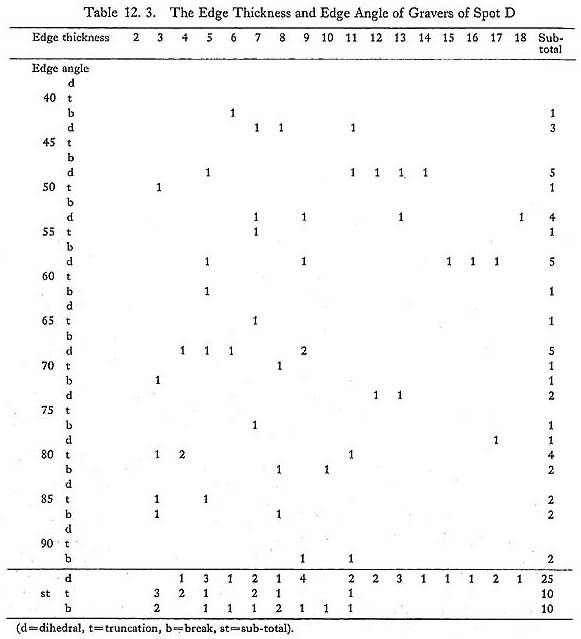
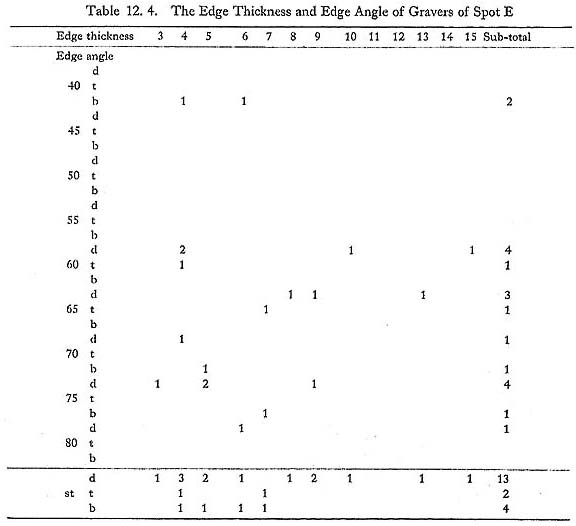
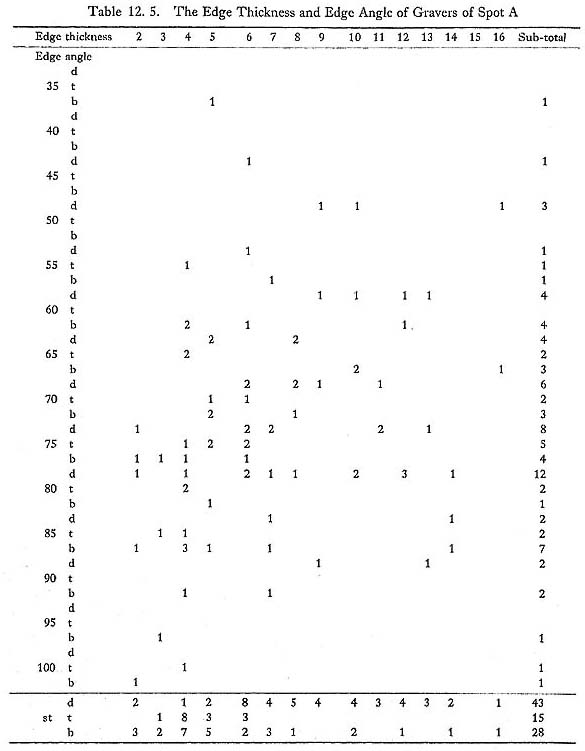

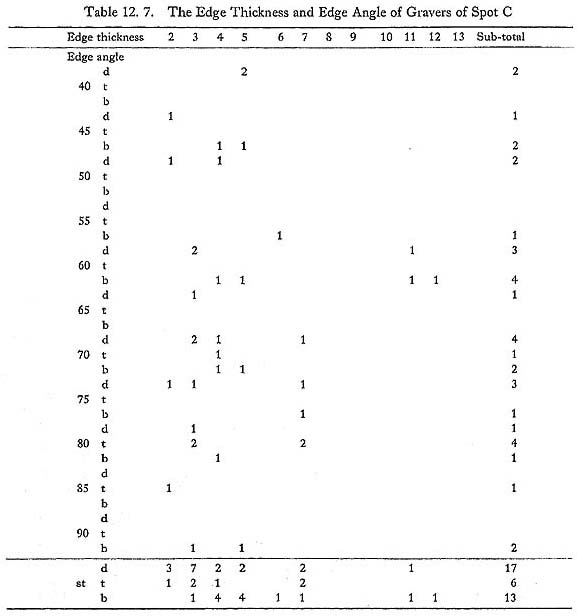
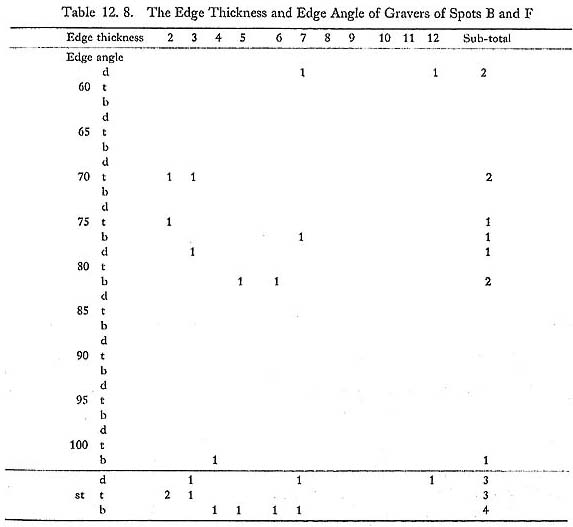
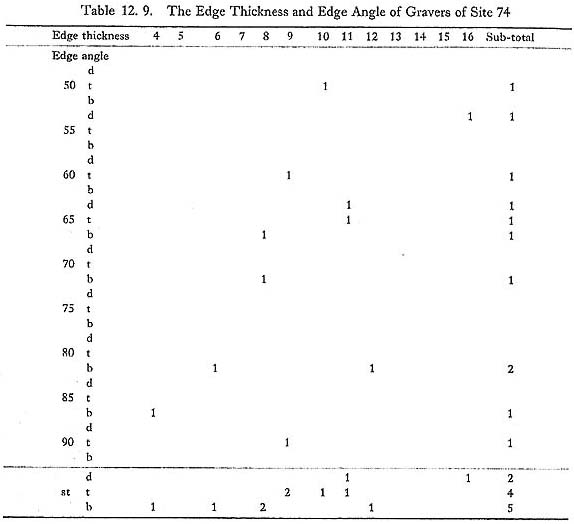
Most of the gravers of the truncation type are small. The edge thicknesses
of dihedral and break gravers vary greatly and the edge angles of the three
types are also variable. Most of the three types of gravers have edge angles
of from 60 to 80 degrees. Differences in edge angles between the three types
of gravers was not observed. There are dips at 5.5 mm and 9.5 mm in the distributions
of the edge thicknesses of the gravers of each assemblage. Gravers were, therefore,
divided into three categories by the edge thicknesses of 5.5 mm and 9.5 mm:
small (edge thicknesses of less than 5.4 mm), medium (edge thicknesses between
5.5 mm and 9.4 mm), and large (edge thicknesses of more than 9.5 mm). The
percentages of the three types and the three categories of gravers are seen
in Table 12. 10. The mean value is shown in Table 12. 11. Of these tables,
the following can be said.
1. Dihedral gravers decreased in the following order: Spots D and E→Spot
A, and Douara Cave→Spots B, C, and F. In the same order truncation and
break gravers increased.
2. Small-sized gravers increased in the following order: Spots D, E, and A→Douara
Cave→Spots B, C, and F. Large-sized gravers decreased in the same order.
3. The gravers of Site 74 are unique in both ratio of size and the ratio of
type. The thicknesses of the edges of gravers from Site 74 are the greatest;
no true dihedral gravers were found and multi-faceted gravers were abundant.
Concerning the attributes of the gravers, the assemblage of Site 74 has no
close connection with the other assemblages.
4. The gravers from Spots B, C, and F and of the Douara Cave were smaller.
The proportions of edge thicknesses are greatly different from those from
Spots A, D, and E. It is interesting to note that gravers with small edge
thicknesses increased and gravers with large edge thicknesses decreased in
number in the assemblages of Spots B, C, and F and those of the Douara Cave.


On the observations of the edge damage of the gravers, three types of edge damage are recognized: a) edge damage is concentrated mainly on the surface of the edge, b) edge damage is seen only on the corner of the edge, and c) edge damage is seen only on the dorsal or ventral surface of the edge. It is supposed that the gravers having the edge damage of type a) might be moved perpendicularly to the edge, the gravers having the edge damage of type b) might be moved obliquely to the edge, and the gravers having the edge damage of type c) might be moved parallelly to the edge.
The gravers of Site 74 have only the edge damage of type a). Most of the gravers of Spots D, E, and A have edge damage of type a) (about 80%). Some of the gravers of Spots D, E, and A have the edge damage of type b) and c). The gravers of Stratigraphic Units A and B of Horizon II of the Douara Cave have the edge damage of type a) (70%), type b) (12%), and type c) (18%). In the edge damage of the gravers of Spot C, the edge damage of type c) increased (about 40%) and that of type a) decreased (about 45%). The edge damage of the gravers of Spots B and F resembles that of Spot C.The types of the edge damage of the gravers vary as follows: Site 74→appearing
type b) and c)→Spots D, E, and A→decreasing type a)→Stratigraphic
Units A and B of Horizon II of the Douara Cave→increasing type c)→Spots
B, C, and F. Over half of the gravers of Site 74, and Spots A, D, and E have
hard edge damage and less than one-third of the gravers of Horizon II of the
Douara Cave, Spots B, C, and F have hard edge damage.
The use of the gravers clearly changed.
These indicate that the tasks of the gravers of Geometric Kebaran A apparently were different from those of the gravers of Spots A, D, and E. The dominance of gravers with small sized edges and increasing parallel moving use in the assemblages of Geometric Kebaran A may be closely related to the abundance of microliths there.
12. 2. 3 End-scrapers
On the end-scrapers, edge thicknesses, edge widths, and edge angles were
measured (Fig. 12.1). As seen in Tables 12.19 and 12.20, edge widths vary
greatly. Very interesting features were observed concerning the relationships
of edge thicknesses, edge angles, and traces of wear. As mentioned in the
paragraph on the traces of wear in end-scrapers from Spot A, most scrapers
having a thick edge have hard edge damage. The edge thicknesses of the end-scrapers
of each assemblage have some variation, but all of them have the dip in distribution
and show a bi-modal distribution (Tables 12. 12-12. 18).
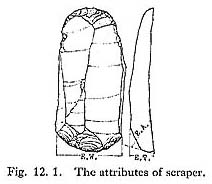
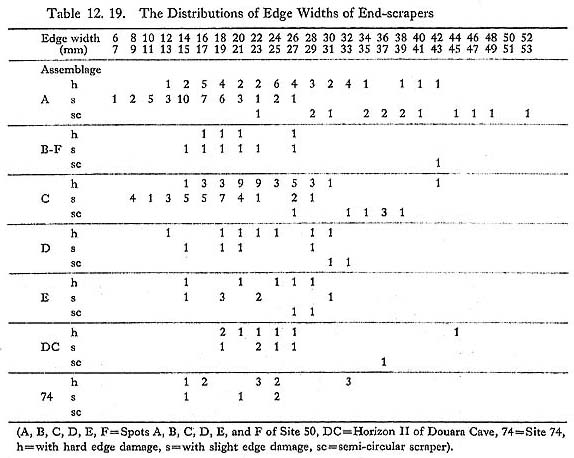
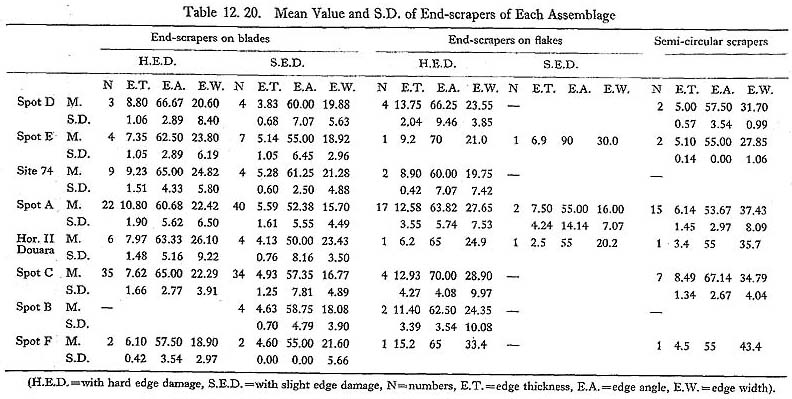
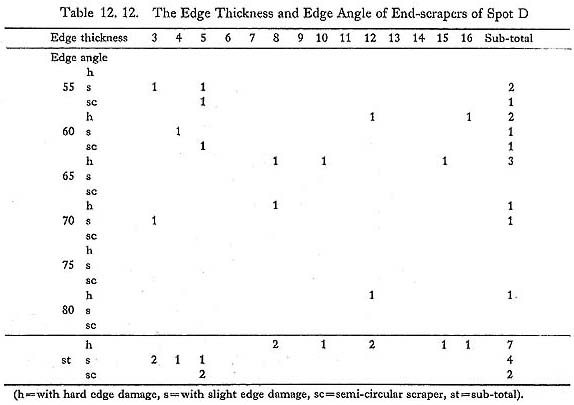

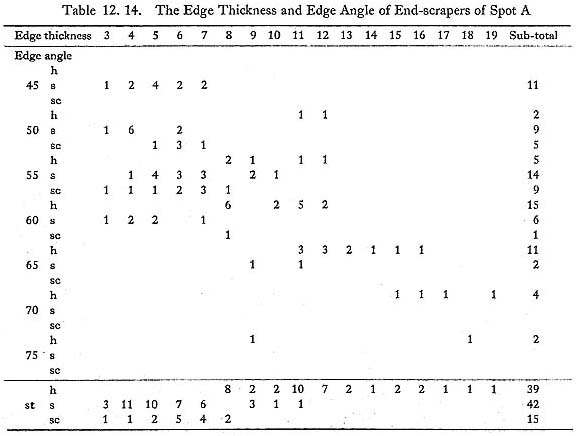

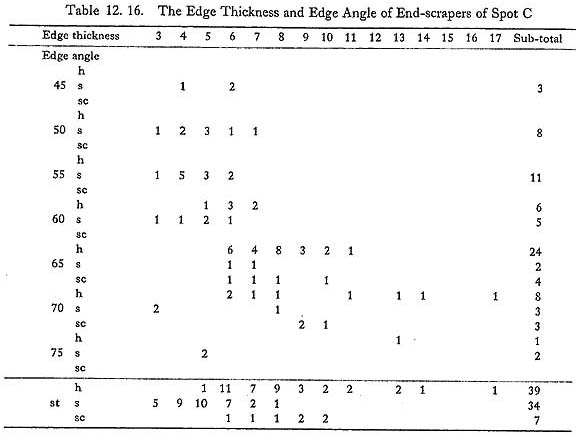

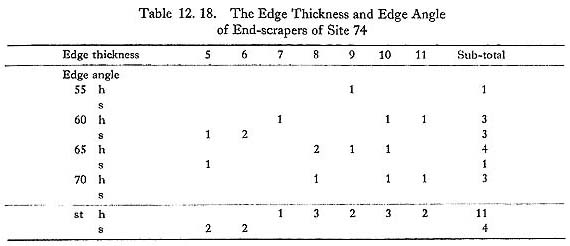
Semi-circular scrapers were excluded from this analysis because they have
different traces of wear as described in the paragraph on the scrapers of
Spot A.
The dip in distribution was observed at the following point: Spot A; 7.5 mm, all others; 6.0 mm. Most end-scrapers with edge thicknesses greater than the dip have edge angles of more than 60 degrees, and most end-scrapers with edge thicknesses smaller than the dip have edge angles of less than 60 degrees. On most end-scrapers in all assemblages having edge thicknesses of more than 10 mm, very hard edge damage is seen. Generally speaking, it was observed that those with thicker edges have harder edge damage.
According to the thickness of the edge, end-scrapers are divided into two categories at the dip. Each category of end-scraper has different traces of wear. These differences mean that these two categories of end-scrapers had different tasks. This relation was not accidental; the two types of end-scrapers were produced for two different purposes. These two categories of end-scrapers are commonly observed in every type of end-scraper, endscraper on a blade, flake, core-rejuvenated flake or crested flake, and keeled scraper with the exception of semi-circular scrapers. This may mean that typologically different types of end-scrapers had the same tasks. End-scrapers made on flakes, on core-rejuvenated flakes or on crested flakes, and keeled scrapers have large edge thicknesses.
The edge thicknesses of the end-scrapers of Spots A, D, and E are larger than those of Spots B, C, and F (Table 12. 20).
In edge widths, no outstanding feature was observed (Tables 12. 19 and 12, 20). Endscrapers with edge widths of more than 25 mm have large edge thicknesses and hard edge damage.
Semi-circular scrapers are small in number. The semi-circular scrapers of Spot C are unique: their edges are thicker than those of the other assemblages and they have hard edge damage. The semi-circular scrapers of the other assemblages have thin edges and have slight edge damage. This phenomenon means that the tasks of the semi-circular scrapers differed in the assemblage of Spot C.
The assemblages of Spots D and E have only a small number of end-scrapers
as compared with the other assemblages but have large numbers of core-scrapers.
These corescrapers have large-sized edge thicknesses and most of them have
hard edge damage. In the assemblages of Spots D and E, core-scrapers served
the tasks of end-scrapers.
The percentages of these three categories of scrapers, those with hard edge
damage, those with slight edge damage, and semi-circular scrapers, are shown
in Table 12. 21. Semi-circular scrapers became a little and end-scrapers with
hard edge damage and those with slight edge damage have almost the same ratio
in the assemblages of Spots B, C, and F, and those of Horizon II of the Douara
Cave. However, in the assemblages of Spots A, D, and E, semi-circular scrapers
occupy about 15% of the total. Site 74 was very different from the rest. In
this assemblage, no semi-circular scrapers were found and a high percentage
of end-scrapers with hard edge damage exists.

Core-scrapers can be added to the hard edge damage category. The percentage
of corescrapers accompanied by hard edge damage is shown in Table 12. 22.
This percentage in Spots B, C, and F is identical. The percentage of core-scrapers
with hard edge damage from the Douara Cave is closer to the assemblages of
Spots A, D, and E. The ratio of endscrapers in these assemblages vary as follows:
those of Spots D and E→increasing endscrapers→Spot A→decreasing
semi-circular scrapers→Douara Cave→decreasing corescrapers→Spots
B, C, and F. This change reflects a change in their tasks. The differences
in the ratio of end-scrapers may mean a change in the subsistence system or
daily way of life.

12. 2. 4 Core-scrapers
Of the core-scrapers, edge widths, edge angles, cortex, and twisted scars
of cores were analysed. The most outstanding feature of the core-scrapers
is that there are no corescrapers which have edge angles of between 60 and
75 degrees (Table 12. 23). The edge angles of core-scrapers almost coincide
with the flaking angles of prismatic cores. Because they received modification
to become core-scrapers, it is impossible to precisely measure their original
flaking angles. It is certain that there are no core-scrapers with edge angles
from about 65 to 70 degrees. As Spech (1972: 53) stated theoretically, there
are angles between which the flaking of blanks could not be carried out. Core-scrapers
were divided into two categories, flat and steep, by their edge angles. It
is questionable as to whether knappers intentionally flaked those. On the
same core-scrapers, steep and flat edges are seen.
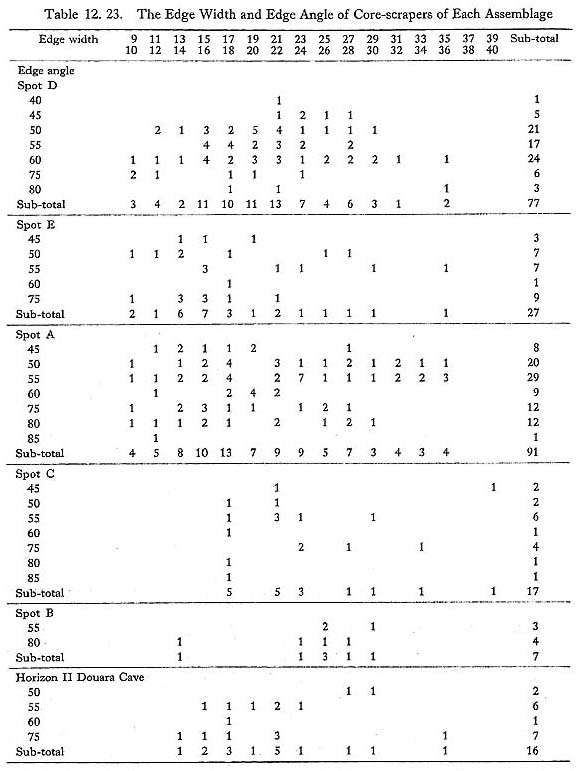
Differences in edge widths were not observed between the flat and steep
specimens. Most of the specimens having twisted scars have flat edges and
large edge widths (Table 12. 24).
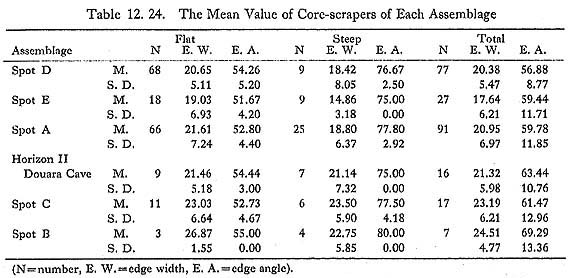
Fairly large numbers of core-scrapers have twisted flaking scars (Table
12, 25), so their edge widths are larger than the widths of their blanks.
The edge widths of some of these specimens are twice that of the widths of
blanks.
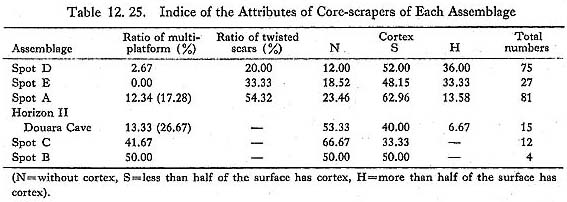
The edge widths of core-scrapers grow larger in the following order: Spots D and E→Spot A→Douara Cave→Spots B and C. This tendency can be seen more clearly in steep type core-scrapers which have few twisted scars.
The cortex of the core-scrapers is divided into three categories: N: without cortex on their surfaces; S: only a small part or less than half of the surfaces have cortex; H: more than half of the surfaces have cortex. As shown in Table 12. 25, cortex decreases in the following order: Spots D and E→Spot A→Douara Cave→Spots B and C. About half of the core-scrapers of Spots D and E were made on flint slabs with widths of 10 to 25mm, and those of B and C were made on larger sized raw material. As seen in Table 12. 25, all core-scrapers of Spots D and E have a single platform with the exception of two specimens. One specimen with bi-directional flaking used both ends of the same platform as a flaking point. In the core-scrapers of Spot A, 12.34% have two-platforms. Four specimens have bi-directional flaking scars, but only one platform remains on the surface of a core-scraper. If these are added to the two-platform category, 17.28% of all core-scrapers have two-platforms. In the case of Spot A, most two-platforms are positioned at the simple opposite side. In the core-scrapers of the Douara Cave, 13.33% of them have bi-directional flaking scars and twoplatforms and otherwise, two specimens have bi-directional flaking scars, but only one platform remains. When they are added to the two-platform category, 26.67% of all corescrapers are bi-directionally flaked. In the core-scrapers of Spots B and C, fairly large numbers are bi-directionally flaked. The directions of flaking are random and a tri-directionally flaked specimen is seen in the core-scrapers of Spot B.
As mentioned above, in the analysis of edge widths, cortex, numbers of platforms, and edge angles, it is clarified that the core-scrapers changed in the following order: Spots D and E→Spot A→Douara Cave→Spots B and C. The differences between Spot A and Douara Cave are greater.
Twisted scars are seen often in the core-scrapers of Spot A (Table 12. 25). On the core- scrapers of Spots B and C and of Douara Cave, no twisted flaking scars were found. In the assemblages of Spots D and E, twisted bladelets are small in number, but the blades of these spots are frequently twisted. As previously mentioned, blades were first flaked from cores of large material, core-rejuvenations were carried out, then bladelets were flaked. Evidence of this process was observed in the assemblages of Stratigraphic Units A and B of Horizon II of the Douara Cave and this same system of production for blades and bladelets was practiced in Spots D and E. If this supposition is correct the twisted scars of blades were removed by later flaking, so the remaining scars of bladelets would not be twisted. In the assemblages of Spots D and E, more twisted specimens are believed to have existed from the features of the blades of these two spots.
Only one core-scraper was collected from Site 74. This specimen has twisted scars and about half of the surface has cortex. This specimen has closer connections with the core-scrapers of Spots A, D, and E than those of Spots B and C and the Douara Cave.
Overall, as it was brought out in Geometric Kebaran A, large-sized raw material was preferred and bi-directional flaking was fairly often practiced.
12. 2. 5 Blades and bladelets
The mean values and S.D.s of lengths, widths, and thicknesses of blades
and bladelets of each assemblage are shown in Table 12. 26. Smilarity can
be observed between Spots D and E, between the two collections of Spot A,
between the two assemblages of the Douara Cave, and between Spots B, C, and
F. Values of Site 74 are larger than those of the other assemblages; the features
of the blades and bladelets of Site 74 are very special in our collection.
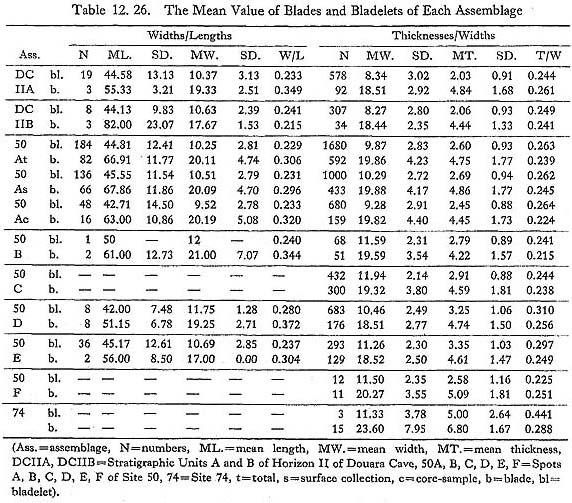
12. 3 PROBLEMS ON CHRONOLOGICAL RELATIONSHIPS
As previously mentioned, attributes analysis shows that the assemblages under study here can be divided into three groups: 1) the assemblages of Spots D, E, and A; 2) the assemblages of Spots B, C, F and Stratigraphic Units A and B; 3) the assemblage of Site 74. Among the group consisting of Spots D, E, and A, fairly large differences between Spots D plus E and Spot A can be observed, and among the group consisting of Spots B, C, F and the Douara Cave, relatively large differences can be observed between the assemblages of Spots B, C, and F and the assemblages of the Douara Cave. The grouping of assembalges mentioned in previous chapters is confirmed by analyses from other points of view.
The assemblages of the later Upper Paleolithic and the Epi-Paleolithic in
the Levant have remarkable variability and it is difficult to classify them
firmly by comparing the percentage of each type of retouched tool. For reference,
Hours' (1974) type list of these assemblages is shown in Table 12. 27. Hours
excluded core-scrapers from his type list (Hours et al., 1973: 273; Hours,
1974). This is to some degree possible from a morphological point of view,
but it cannot be agreed to from a functional point of view. As attribute analyses
of the assemblages show, tasks for core- or steep-scrapers were wide ranging
in the Upper Paleolithic and the Epi-Paleolithic in the Levant and were very
different from the tasks of the core-scrapers of the Upper Paleolithic assemblages
in France. In some assemblages of the Upper Paleolithic in the Levant, core-scrapers
were used to carry out the bulk of all scraping tasks. The question arises
as to whether core-scrapers were merely byproducts of blade and bladelet production.
In the assemblages of Spots D and E, most prismatic cores were used as core-scrapers
while only a small number of blades and bladelets had a secondary retouch.
The blades and bladelets without retouch were used, but their utilization
patterns had little uniformity.Quantitative analyses may show that core-scrapers
were not merely by-products.
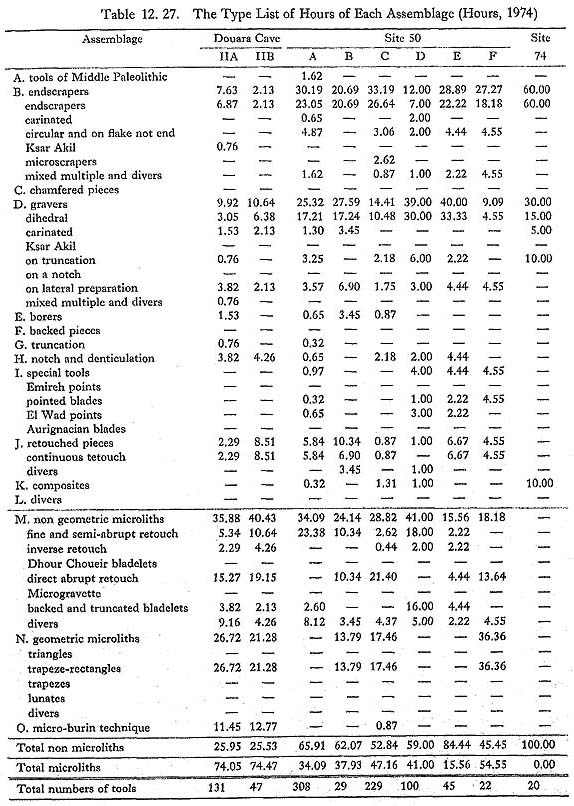
Chronological discussion follows.
12. 3. 1 The assemblages of Spots D and E
These bear a close relationship to the assemblages of layer 1 and 2 of rock-shelter II of Jabmd (Rust, 1950: 89-99) and have some affinity with the assemblage of El Wad C (Garrod, 1937: 41). Their features include a high percentage of core- or steep-scrapers, their gravers outnumber end-scrapers, blades are of poor quality and are small in number, and there are large numbers of bladelets. These two assemblages can be assigned to Atlitian as described by Garrod (1937: 41), or to a variation of Levantine Aurignacian C as described by Copeland (1975: 343). However, because assemblages of this stage have not been well investigated and studied (Hours et al., 1973: 273), precise comparisons between them are impossible.
12. 3. 2 The assemblage of Spot A
The types of microliths of this assemblage resemble those of early Kebaran, stage A as described by Hours (1976: 119). Most of the microliths of this assemblage are finely or semiabruptly backed bladelets. In this assemblage end-scrapers outnumber gravers and long end-scrapers are dominant. Microliths are not as abundant as they were at Kebaran. All of the above differences are distinct. This assemblage has some affinity with the assemblages of Spots D and E. Attribute analysis shows that the assemblage of Spot A and the assemblages of Spots D and E have both affinity and some differences. A very interesting microlithic point which can be positioned between the El Wad point and the Kebarah point was found. A characteristic perpendicularly truncated bladelet was also found in this assemblage. The assemblage of layer 8 of rock-shelter III of Jabrud, named Skiftian by Rust (1950: 103-107), has the same type of truncated bladelet and has a close relationship with this assemblage. The assemblage of Spot A has finely backed bladelets, core-scrapers, end-scrapers on blades, gravers of various types, and El Wad points. The assemblage of layer 8 of rock-shelter III of Jabrud coincides with this assemblage in many respects-one of these being that the Jabrud layer lies under the layers that contained Kebaran assemblages. This shows that this assemblage belongs to the transient stage between Atlitian or Levantine Aurignacian C and Kebaran. From this we may conclude that the assemblage of Spot A is positioned between Atlitian or Levantine Aurignacian C and Kebaran, and has a close relationship with Skiftian. Because this assemblage has a relatively small number of microliths, it can be dated to the terminal Upper Paleolithic period. This type of assemblage, as far as the writer knows, is seldom found in the Levant; it may be a regional type of the terminal Upper Paleolithic period around the Syrian Desert area.
12. 3. 3 The assemblages of Spots B, C, and F, and Horizon II of the Donara Cave
These assemblages are assigned to Geometric Kebaran A as described by Bar-Yosef (1970, 1975, 1976) because they have fairly large numbers of trapeze-rectangles. As stated previously, some differences can be observed between the assemblages of Spots B, C, and F, and the assemblages of Stratigraphic Units A and B of Horizon II of the Douara Cave. Differences are especially great concerning microliths. According to Bar-Yosef (1976: 97), assemblages of the later stage of Geometric Kebaran A have wider trapeze-rectangles with an abrupt retouch. The trapeze-rectangles of these five assemblages have an abrupt retouch and belong to the wider type of trapeze-rectangles of Bar-Yosef. Therefore, they can be assigned to the later stage of Geometric Kebaran A. The trapeze-rectangles of Spots B, C, and F are wider than those of the Douara Cave. The assemblages of the Douara Cave have some affinity with that of Spot A. From this, it can be concluded that the assemblages of Spots B, C, and F are later than those of the Douara Cave. However the differences between them cannot be explained merely by a difference in time. The differences of small-sized artifacts may be explained by the sieving, but differences are also observed in the ordinary-sized tools. In the assemblages of the Douara Cave non-retouched artifacts are strong and although in small numbers, nodules of flint were found. The assemblages of the Douara Cave have some degree of atelier characteristics. Differences in the micro-burin techniques may be explained by the possibility that they belonged to different cultural traditions, or that different ethic groups existed. The assemblages of Geometric Kebaran A have much variability as was pointed out by Bar-Yosef (1976: 94). Around the Syrian Desert area very few assemblages have been reported, so precise comparisons are impossible.
12. 3. 4 The assemblage of Site 74
This assemblage is very different from other assemblages. The other assemblages dealt with in this article have certain affinities between them, but this assemblage has little affinity with those. Small numbers of bladelets and core-scrapers, no dihedral gravers, and fairly large numbers of high quality blades are characteristic of this assemblage. These features are not observed in the other assemblages. Site 74 has some affinity with the assemblages of layers 9 and 10 of rock-shelter III of Jabrud (Rust, 1950: 101-103), which are poor assemblages, too. The Jabrud assemblages have end-scrapers on large-sized blades and small numbers of dihedral gravers. Non-dihedral gravers are also found, but other tools are very scarce. These two assemblages are unique in the cultural continuity of Jabrud, According to Marks (1976a: 73), at least two traditions existed in the Upper Paleolithic in Southern Levant. The differences are remarkable. In the Syrian Desert, two cultural traditions were supposed to have existed. This collection is too poor to be categorized with certainty.
12.4 SUMMARY
Nine assemblages are dated to the terminal Upper Paleolithic and the Epi-Paleolithic periods. Between the assemblages of the terminal Upper Paleolithic and the assemblages of the Epi-Paleolithic, differences are remarkable. This phenomenon may reflect a change in subsistence patterns or a change due to adaptation to the environment. Paleoenviron-mental data and precise data concerning the artifacts are so scarce in the vicinity of the Palmyra Basin that detailed discussion is impossible. However, the following suppositions may be made.
At the time of Spot A, many microliths were added to the assemblages similar to those of Spots D and E. This means that the tasks of microliths increased rapidly and that at this time typological specialization of microliths based on their functions began. Accompanying this change, other types of tools changed and new types of tools appeared. The tasks of microliths increased during the Kebaran stage and various types of microliths appeared and disappeared. During the Kebaran stage or the early stage of Geometric Kebaran A, the tasks of microliths gradually changed from moving parallel to their edges to moving perpendicular to their edges. Accompanying this change the tasks of other tools changed. For example, the size of gravers and end-scrapers became smaller, semi-circular scrapers became thicker and were used for different tasks, and the manufacture of core-scrapers decreased markedly. These phenomena were observed in the assemblages of the later stage of Geometric Kebaran A and may reflect a change in the subsistence system or a change due to adaptation of some sort.
Differences in the environment are great in the Levant and adaptations to these environments are various. A microenvironmental study is necessary to clarify the features of the subsistence system and the adaptation patterns of prehistoric populations in the Levant. Thus, it is necessary to investigate the restricted area completely, as Marks investigated in the Negev (Marks, 1976b). Through such investigations, the chronology of the restricted area, the paleoenvironmental studies of the restricted area, and through precise analysis of the artifacts from various points of view, the prehistory of the Levant must be studied to clarify the origin of Food Production.
LITERATURE CITED
- Bar-Yosef, O. (1970)
- Prehistoric Sites near Ashdad, Israel. Palestine Exploration Quarterly, 1970 Jan.-June: 52-63.
- Bar-Yosef, O. (1975)
- The Epipaleolithic in Palestine and Sinai. In: Wendorf and Marks (eds.), 1975:363-378.
- Bar-Yosef, O. (1976)
- A Note on the Geometric Kebaran A. Pre-Conference Papers for IXth International Congress of Pre- and Proto-historic Science, Nice, Colloque III: 78-105.
- Clay, R.B. (1976)
- Typological Classification, Attribute Analysis and Lithic Variability. Journal of Field Archaeology, 3: 303-311.
- Copeland, L. (1975)
- The Middle and Upper Paleolithic of Lebanon and Syria in the Light of recent Research. In: Wendorf and Marks (eds.), 1975: 317-350.
- Garrod, D.A.E. and Bate, D. (1937)
- The Stone Age of Mt. Carmel. vol. I, Oxford.
- Henry, D.O. (1974)
- The Utilization of the Microburin Technique in the Levant. Paleorient, 2: 389-398.
- Hours, F. (1974)
- Remarques sur l'utilisation des listes-types pour l'étude du Paléolithique Supérieur et de l'Epipaléolithique du Levant. Paleorient, 2: 3-18.
- Hours, F, (1976)
- L'Epipaléolithique au Liban. Résultats acquis en 1975, Pre-Conference Papers for IXth International Congress of Pre- and Proto-historic Science, Nice, Colloque III: 106-130.
- Hours, F., Copeland, L. et Aurenche, O. (1973)
- Les industries paléolithiques du Proche-Orient, essai de corrélation. L'Anthropologie, 77: 229-280, 437-496.
- Marks, A.E. (1976a)
- Terminology and chronology of the Levantine Upper Paleolithic as seen from the Central Negev, Israel. Pre-Conference Papers for IXth International Congress of Pre- and Proto-historic Science, Nice, Colloque III: 49-76.
- Marks, A.E. (ed.) (1976b)
- Prehistory and Paleoenvironments in the Central Negev Israel. Dallas.
- Moore, A.M.T. (1975)
- The Excavation of Tell Abu Hureira in Syria: A preliminary report. Proceedings of the Prehistoric Society, 41: 50-69.
- Movius, H.L. Jr., David, N.C., Bricker, H.M. and Clay, R.B. (1968)
- The analysis of certain major classes of Upper Paleolithic Tools. American School of Prehistoric Research, 26.
- Rust, A. (1950)
- Die Höhlenfunde von Jabrud (Syrien). Neumünster.
- Sackett, J.R, (1966)
- Quantitative analysis of Upper Paleolithic stone tools, American Anthropologist, 68: 356-394.
- Spech, J.D. (1972)
- Mechanical basis of percussion flaking. American Antiquity, 37: 34-60.
- Wendorf, F. and Marks, A.E. (eds.) (1975)
- Problems in Prehistory: North Africa and the Levant. Dallas.